Climate data guide content with tag Global
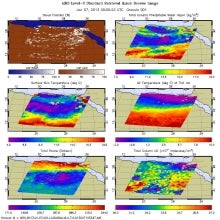 AIRS (Atmospheric InfraRed Sounder): Version 6 Level 2
AIRS (Atmospheric InfraRed Sounder): Version 6 Level 2
Years of record
- to
AIRS Version 6 Level 2 data represent a significant improvement over AIRS Version 5 Level 2 products in terms of greater stability, yield, and quality. Several algorithmic improvements have been made by the AIRS Project in conjunction with the AIRS Science Team. Improvements include: (a) Improved soundings of Tropospheric and Sea Surface Temperatures, day and night…
Main variables and Earth System components
Atmosphere Aerosols Air Temperature CO Geopotential Height Ozone: Tropospheric Precipitable water Specific HumidityExperts contributing reviews
- N/A
 AIRS and AMSU: Trace Gases (CO2, CO, CH4, O3...); Level 3
AIRS and AMSU: Trace Gases (CO2, CO, CH4, O3...); Level 3
Years of record
- N/A
AIRS provides satellite retrieval of mid-tropospheric carbon dioxide even under cloudy conditions, without the use of a priori information from models. AIRS retrievals use cloud-cleared thermal IR radiance spectra in the 15 micron band with an accuracy better than 2 ppm. AIRS retrievals have been used to produce global maps of carbon dioxide and other trace gases…
Main variables and Earth System components
Atmosphere CO Ozone: Tropospheric Biosphere CH4-Methane CO CO2-
Timestep
- Sub-daily, Daily, Monthly
-
Domain
- Global
-
Collections
- Carbon cycle
Experts contributing reviews
- N/A
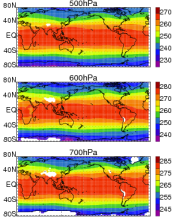 AIRS and AMSU: Tropospheric air temperature and specific humidity
AIRS and AMSU: Tropospheric air temperature and specific humidity
Years of record
- to
The Atmospheric Infrared Sounder (AIRS) project has generated decadal-length, global, gridded data sets of temperature and specific humidity for several standard levels in the troposphere for the obs4MIPS project. This obs4MIPS version of the AIRS data are available at monthly resolution, 1ºx1º grids and formatted to facilitate easier comparisons with CMIP5 model output…
Experts contributing reviews
- Tian, Baijun
An overview of paleoclimate information from high-resolution lake sediment records: Strengths, limitations and key databases
Years of record
- N/A
Accumulated sediments at the bottom of lakes are invaluable archives of past climate and environmental change. These sediments contain a variety of physical, geochemical, and biological proxy indicators that can be used to gain a multi-faceted understanding of past conditions. Unlike other high-resolution paleoclimate archives, such as tree rings, corals, and…
Main variables and Earth System components
Atmosphere Air Temperature Precipitation Biosphere Pollen Land-
Formats
- ascii, csv, Linked Paleo Data (LiPD)
-
Timestep
- Annual, Decadal, Irregular
-
Domain
- Global
-
Collections
- N/A
Experts contributing reviews
- Larocca, Laura, Broadman, Ellie
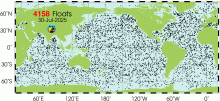 Argo Ocean Temperature and Salinity Profiles
Argo Ocean Temperature and Salinity Profiles
Years of record
- to
Argo is an array of over 4100 profiling floats distributed almost uniformly across the global oceans. First deployed in 2000, Argo floats provide temperature and salinity profiles from the surface to a depth of 2000m. The array has approximately 1 float for every 3 degrees of latitude and longitude, providing a new profile once every 10 days. 'Real-time' data…
Main variables and Earth System components
Ocean Salinity Sub Surface Salinity Sub Surface TemperatureExperts contributing reviews
- Scanderbeg, Megan, Purkey, Sarah, Willis, Josh
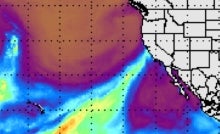 Atmospheric Rivers: The Atmospheric River Tracking Method Intercomparison Project (ARTMIP)
Atmospheric Rivers: The Atmospheric River Tracking Method Intercomparison Project (ARTMIP)
Years of record
- to
ARTMIP is the Atmospheric River Tracking Method Intercomparison Project. The goal of ARTMIP is to provide the community with the data necessary to quantify Atmospheric River (AR) uncertainty due to how ARs are defined or identified in gridded datasets. Atmospheric rivers (ARs) are dynamically driven, filamentary structures that account for ~90% of poleward water vapor…
Main variables and Earth System components
AtmosphereExperts contributing reviews
- N/A
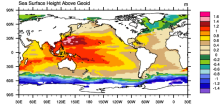 AVISO: Satellite derived Sea Surface Height above Geoid
AVISO: Satellite derived Sea Surface Height above Geoid
Years of record
- to
The sea surface height relative to the geoid (the mean ocean surface of the Earth if the ocean is at rest) is derived from TOPEX/Poseidon, Envisat, Jason-1, and OSTM/Jason-2 altimetry measurements. Altimetry is a technique for measuring height. Satellite altimetry measures the time taken by a radar pulse to travel from the satellite antenna to the surface and back to…
Experts contributing reviews
- N/A
 CALIPSO
CALIPSO
Years of record
- to
CALIPSO (Cloud-Aerosol Lidar and Infrared Pathfinder Satellite Observations ) was launched on April 28, 2006 to study the impact of clouds and aerosols on the Earth's radiation budget and climate. It flies in formation with five other satellites in the international "A-Train" constellation for coincident Earth observations. The CALIPSO satellite comprises three…
Experts contributing reviews
- N/A
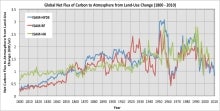 Carbon Emissions from Historical Land-Use and Land-Use Change
Carbon Emissions from Historical Land-Use and Land-Use Change
Years of record
- to
Annual net land-atmosphere carbon flux and net flux of carbon to the atmosphere due to land-use and land-use change (LULUC) are estimated using an integrated assessment model and three historical reconstructions of land use and land use conversion. The data span 1800-2010 and are aggregated for nine regions of the globe.
Main variables and Earth System components
Biosphere CO2 Land CO2 Land-Atmosphere flux Land Cover Type Land Use ConversionExperts contributing reviews
- Meiyappan, Prasanth
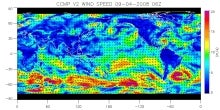 CCMP: Cross-Calibrated Multi-Platform wind vector analysis
CCMP: Cross-Calibrated Multi-Platform wind vector analysis
Years of record
- to
The CCMP wind analysis is a near-global, high spatial and temporal resolution gridded dataset of surface wind vectors spanning 1987-present. The input data are a combination of inter-calibrated satellite data from numerous radiometers and scatterometers and in-situ data from moored buoys. An algorithm finds a best-fit solution to all of the available…
Experts contributing reviews
- Ricciardulli, Lucrezia
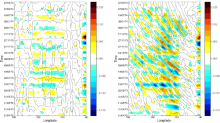 CERA-20C: ECMWF's Coupled Ocean-Atmosphere Reanalysis of the 20th Century
CERA-20C: ECMWF's Coupled Ocean-Atmosphere Reanalysis of the 20th Century
Years of record
- to
The CERA-20C is a global, coupled reanalysis spanning 1901-2010 with a focus on low-frequency climate variability. Similar to ERA-20C, the surface observations assimilated include surface pressures from the International Surface Pressure Databank v3.2.6 and ICOADS v 2.5.1, and surface winds over the oceans from ICOADSv2.5.1. Upper-air and satellite data are…
Main variables and Earth System components
Atmosphere Multiple variables Cryosphere Sea Ice Concentration OceanExperts contributing reviews
- Laloyaux, Patrick
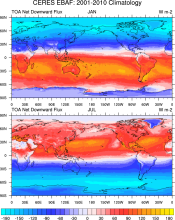 CERES EBAF: Clouds and Earth's Radiant Energy Systems (CERES) Energy Balanced and Filled (EBAF)
CERES EBAF: Clouds and Earth's Radiant Energy Systems (CERES) Energy Balanced and Filled (EBAF)
Years of record
- to
The CERES-EBAF product provides 1-degree regional, zonal and global monthly mean Top-of-Atmosphere (TOA) and surface (SFC) longwave (LW), shortwave (SW), and net (NET) fluxes under clear and all-sky conditions. EBAF is used for climate model evaluation, estimating the Earth's global mean energy budget, and to infer meridional heat transport. The data synthesized to…
Experts contributing reviews
- Loeb, Norman
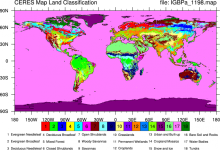 CERES: IGBP Land Classification
CERES: IGBP Land Classification
Years of record
- N/A
The International Geosphere–Biosphere Programme (IGBP) defines ecosystems surface classifications. The CERES (Clouds and Earth's Radiant Energy System)10-minute data can be used to derive the land categories.
Experts contributing reviews
- N/A
 CHELSA high-resolution land surface temperature and precipitation
CHELSA high-resolution land surface temperature and precipitation
Years of record
- to
The Climatologies at high resolution for the Earth's land surface (CHELSA) dataset contains high spatial resolution monthly climatologies of mean, maximum and minimum temperatures and mean precipitation, representing the period 1979-2013. CHELSA is essentially a statistical downscaling of the ERA-Interim reanalysis, with the temperature downscaling based on mean…
Experts contributing reviews
- Karger, Dirk
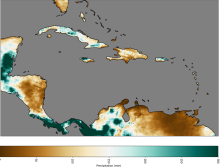 CHIRPS: Climate Hazards InfraRed Precipitation with Station data (version 2)
CHIRPS: Climate Hazards InfraRed Precipitation with Station data (version 2)
Years of record
- to
Note: CHIRPS v2 has been superseded by CHIRPS v3 as of June 2025. Climate Hazards Group InfraRed Precipitation with Station data (CHIRPS) is a quasi-global (50S - 50N), land-only rainfall dataset with a range of temporal and spatial resolutions depending on the region and the time period. Data can be found at 0.05 deg or 0.1 deg resolution, and can be found at 6-hourly…
Experts contributing reviews
- Touma, Danielle, Martinez, Carlos
 CHIRPS: Climate Hazards InfraRed Precipitation with Station data (Version 3)
CHIRPS: Climate Hazards InfraRed Precipitation with Station data (Version 3)
Years of record
- to
Climate Hazards Group InfraRed Precipitation with Station data version 3 (CHIRPS v3)is a 1981-present, land-only, high resolution 0.05° gridded precipitation dataset. It combines thermal-infrared geostationary satellite-based estimates (CHIRP3), in situ observations from global, regional, and national meteorological networks, and a high-resolution climatology (CHPclim2…
Main variables and Earth System components
Precipitation-
Formats
- GeoTIFF
-
Timestep
- Climatology, Monthly, Annual, Pentad
-
Domain
- Africa, Global, South America
-
Collections
- N/A
Experts contributing reviews
- Alaso, Daniella
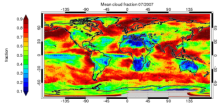 CLARA-A1: Cloud properties, surface albedo and surface radiation products based on AVHRR
CLARA-A1: Cloud properties, surface albedo and surface radiation products based on AVHRR
Years of record
- to
"CLARA-A1 (CLoud, Albedo and RAdiation dataset, AVHRR-based, version 1) is a global dataset of cloud properties, surface albedo and surface radiation products, generated by the EUMETSAT Satellite Application Facility on Climate Monitoring (CM SAF). The products are derived from measurements of the Advanced Very High Resolution Radiometer (AVHRR) onboard the polar…
Main variables and Earth System components
Atmosphere Cloud Properties Liquid Water Path Radiation Surface albedo-
Formats
- netCDF
-
Timestep
- Daily, Monthly, Pentad
-
Domain
- Global
-
Collections
- Climate Data Record
Experts contributing reviews
- Stengel, Martin
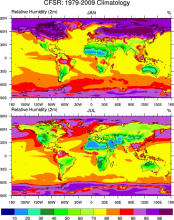 Climate Forecast System Reanalysis (CFSR)
Climate Forecast System Reanalysis (CFSR)
Years of record
- to
The CFSR is a third generation reanalysis product. It is a global, high resolution, coupled atmosphere-ocean-land surface-sea ice system designed to provide the best estimate of the state of these coupled domains over this period. The CFSR includes (1) coupling of atmosphere and ocean during the generation of the 6 hour guess field, (2) an interactive sea-ice model, and…
Main variables and Earth System components
Atmosphere Air Temperature Geopotential Height Precipitable water Ocean-
Formats
- GRIB
-
Timestep
- Sub-daily, Monthly
-
Domain
- Global
-
Collections
- Climate Analysis Section (CAS) Data Catalog
Experts contributing reviews
- N/A
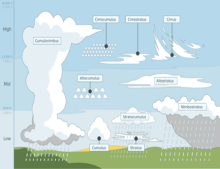 Cloud Dataset Overview
Cloud Dataset Overview
Years of record
- to
Clouds cover about 70% of the earth's surface. They are important components of the cliimate's water and energy budgets. Historically, cloud reports have come from station or ship observations. The satellite observation era, beginning in the 1980’s and spanning now more than 30 years, allows to capture clouds and their properties over the entire globe and across a…
-
Formats
- N/A
-
Timestep
- Climatology, Monthly
-
Domain
- Global
-
Collections
- Overview / Comparison page
Experts contributing reviews
- Stubenrauch, Claudia
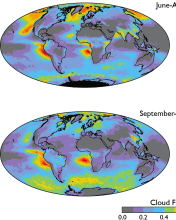 Cloud observations from MODIS
Cloud observations from MODIS
Years of record
- to
The Moderate Resolution Imaging Spectroradiometer (MODIS) is scanning instrument that makes measurements in 36 spectral bands from the visible to the thermal infrared at spatial resolutions from 250 m to 1 km. There are MODIS instruments aboard two sun-synchronous polar-orbiting NASA satellites: Terra, which has a daytime equatorial crossing at about 10:30 am local time…
-
Timestep
- Daily, Monthly, Weekly
-
Domain
- Global
-
Collections
- Diagnostic Data Sets, NCAR-DOE-CESM, atmosdiagnostics, Obs4MIPS
Experts contributing reviews
- Pincus, Robert
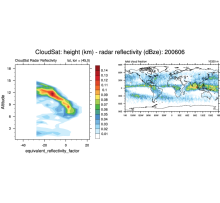 CloudSat
CloudSat
Years of record
- to
CloudSat is a satellite mission designed to measure the vertical structure of clouds from space. The radar data produces detailed images of cloud structures. CloudSat is one of a constellation of satellites known as the A-Train (Cloudsat, CALIPSO, PARASOL, Aqua, Aura, GCOM-W1). The satellites fly in a nearly circular orbit with an equatorial altitude of approximately…
Experts contributing reviews
- N/A
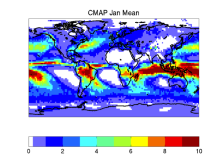 CMAP: CPC Merged Analysis of Precipitation
CMAP: CPC Merged Analysis of Precipitation
Years of record
- to
CMAP refers to a collection of precipitation data sets, though the 2.5°x2.5° global monthly version is probably the most widely used. This data set is constructed from an analysis of gauge data and satellite-derived precipitation estimates. An "enhanced" version (CMAP/A) is also available, which provides global coverage by filling in gaps with precipitation forecasts…
-
Timestep
- Monthly, Pentad
-
Domain
- Global
Experts contributing reviews
- Arkin, Phil, Xie, PIngping
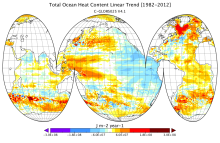 CMCC Global Ocean Reanalysis System (C-GLORS)
CMCC Global Ocean Reanalysis System (C-GLORS)
Years of record
- to
"The CMCC Global Ocean Physical Reanalysis System (C-GLORS) is used to simulate the state of the ocean in the last decades. It consists of a variational data assimilation system (OceanVar), capable of assimilating all in-situ observations along with altimetry data, and a forecast step performed by the ocean model NEMO coupled with the LIM2 sea-ice model…
Main variables and Earth System components
Ocean Ocean Heat Content SST - sea surface temperature Salinity Sub Surface Salinity Sub Surface Temperature mixed layer depth sea surface height u, v current componentsExperts contributing reviews
- Storto, Andrea
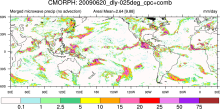 CMORPH (CPC MORPHing technique): High resolution precipitation (60S-60N)
CMORPH (CPC MORPHing technique): High resolution precipitation (60S-60N)
Years of record
- to
"CMORPH (CPC MORPHing technique) produces global precipitation analyses at very high spatial and temporal resolution. This technique uses precipitation estimates that have been derived from low orbiter satellite microwave observations exclusively, and whose features are transported via spatial propagation information that is obtained entirely from geostationary satellite…
Experts contributing reviews
- N/A
 Combined CloudSat spaceborne radar and CALIPSO spaceborne lidar cloud fraction dataset (3S-GEOPROF-COMB)
Combined CloudSat spaceborne radar and CALIPSO spaceborne lidar cloud fraction dataset (3S-GEOPROF-COMB)
Years of record
- to
A global (82S-82N) cloud fraction data set, providing a unique view of cloud vertical structure, has been developed based on the complimentary spaceborne remote sensing capabilities of the CloudSat radar and the CALISPSO lidar. The data set provides monthly mean cloud fraction over several vertical layers for 2006-2019.
-
Formats
- netCDF
-
Timestep
- Monthly, Seasonal, Annual
-
Domain
- Global
-
Collections
- Diagnostic Data Sets, NCAR-DOE-CESM, atmosdiagnostics
Experts contributing reviews
- Bertrand, Leah, Kay, Jennifer
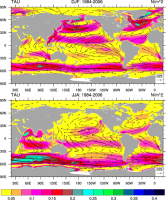 COREv2 Air-Sea Surface Fluxes
COREv2 Air-Sea Surface Fluxes
Years of record
- to
The Coordinated Ocean Research Experiments version 2 (COREv2) data set consists of a globally complete set of air-sea fluxes of momentum, heat and freshwater for 1948-2009 at monthly resolution. This data set serves as a set of common atmospheric boundary conditions that has been used by the ocean modeling community to force and compare a diverse set of…
Main variables and Earth System components
Atmosphere Evaporation Precipitation Radiation Wind Stress Land Runoff and Streamflow Ocean Surface Flux-
Formats
- netCDF
-
Timestep
- Monthly
-
Domain
- Global
-
Collections
- Diagnostic Data Sets, NCAR-DOE-CESM, atmosdiagnostics, oceandiagnostics
Experts contributing reviews
- Yeager, Stephen
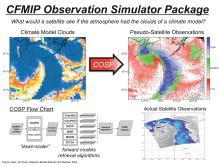 COSP: Cloud Feedback Model Intercomparison Project (CFMIP) Observation Simulator Package
COSP: Cloud Feedback Model Intercomparison Project (CFMIP) Observation Simulator Package
Years of record
- N/A
Cloud processes and feedbacks are recognized as the largest uncertainty in climate model projections. Progress in understanding the roles of clouds in the response of the Earth to changes in external forcing (GHG, aerosoles, etc.) has in part been hampered by the lack of a consistent definition of clouds and cloud types in models and observations. It has been difficult…
-
Formats
- N/A
-
Timestep
- N/A
-
Domain
- Global
-
Collections
- Diagnostic Data Sets, NCAR-DOE-CESM, atmosdiagnostics
Experts contributing reviews
- Kay, Jennifer
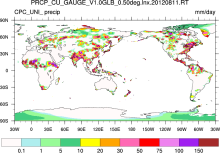 CPC Unified Gauge-Based Analysis of Global Daily Precipitation
CPC Unified Gauge-Based Analysis of Global Daily Precipitation
Years of record
- to
A gauge-based analysis of daily precipitation has been constructed over the global land areas. Gauge reports from over 30,000 stations are collected from multiple sources including GTS, COOP, and other national and international agencies. Quality control is performed through comparisons with historical records and independent information from measurements at nearby…
Experts contributing reviews
- N/A
 CRU TS Gridded precipitation and other meteorological variables since 1901
CRU TS Gridded precipitation and other meteorological variables since 1901
Years of record
- to
The CRU TS series of data sets (CRU TS = Climatic Research Unit Time series) contain gridded monthly fields of precipitation, daily maximum and minimum temperatures, cloud cover, and other variables covering Earth's land areas for 1901-2022 (CRU TS4.0 is the recent major release). The data set is gridded to 0.5x0.5 degree resolution, based on analysis of over 4000…
Main variables and Earth System components
Atmosphere Air Temperature Cloud Properties Maximum Air Temperature Minimum Air Temperature Potential Evapotranspiration PrecipitationExperts contributing reviews
- N/A
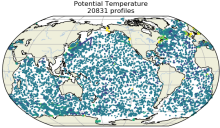 EN4 subsurface temperature and salinity for the global oceans
EN4 subsurface temperature and salinity for the global oceans
Years of record
- to
EN4 is a subsurface temperature and salinity dataset for the global oceans, spanning 1900 to present at a monthly timestep. It includes two types of data products: (1) a database of quality-controled in situ profiles and (2) a spatially complete analyses at 1 by 1 degree horizontal resolution and 42 depth levels for 83S to 90N. Input data include Argo (Argo, 2000), ASBO…
Main variables and Earth System components
Ocean potential temperature Sub Surface Salinity Sub Surface Temperature Sub-surface dataExperts contributing reviews
- Killick, Rachel
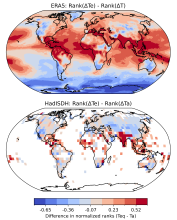 Equivalent Temperature: HadISDH.land and ERA5
Equivalent Temperature: HadISDH.land and ERA5
Years of record
- to
Equivalent temperature is a measure of heat in the atmosphere that accounts for the latent heat stored in water vapor in addition to sensible heat as measured by temperature. The equivalent temperature ($T_e$) scales linearly with the moist enthalpy (i.e., the temperature and humidity) of the atmosphere. Te is computed from: $$T_e = T + \frac{L_v}{C_p} q \tag{1}$$ in…
-
Formats
- N/A
-
Timestep
- Monthly
-
Domain
- Global
-
Collections
- BAMS State of the Climate
Experts contributing reviews
- Matthews, Tom
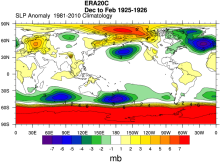 ERA-20C: ECMWF's atmospheric reanalysis of the 20th century (and comparisons with NOAA's 20CR)
ERA-20C: ECMWF's atmospheric reanalysis of the 20th century (and comparisons with NOAA's 20CR)
Years of record
- to
The ECMWF's first atmospheric reanalysis of the 20th Century, ERA-20C, provides a long, gridded dataset of many climate variables, spanning 1900-2010. Observations assimilated include surface pressures from the International Surface Pressure Databank v3.2.6 and ICOADS v 2.5.1, and surface winds over the oceans from ICOADSv2.5.1. Upper-air and satellite data…
-
Timestep
- Sub-daily, Daily, Monthly
-
Domain
- Global
Experts contributing reviews
- Poli, Paul
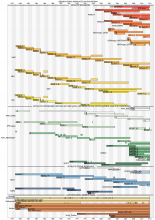 ERA-Interim
ERA-Interim
Years of record
- to
Using a much improved atmospheric model and assimilation system from those used in ERA-40, ERA-Interim represents a third generation reanalysis. Several of the inaccuracies exhibited by ERA-40 such as too-strong precipitation over oceans from the early 1990's onwards and a too-strong Brewer-Dobson circulation in the stratosphere, were eliminated or significantly reduced…
Main variables and Earth System components
Atmosphere Air Temperature Geopotential Height Precipitable water Precipitation-
Timestep
- Sub-daily, Daily, Monthly
-
Domain
- Global
Experts contributing reviews
- Dee, Dick
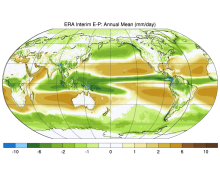 ERA-Interim: derived components
ERA-Interim: derived components
Years of record
- to
Era-Interim data are used to derive monthly mass, moisture and energy budget products. Each term is available. Atmospheric energy, mass, and moisture budgets can be computed by vertically integrating reanalysis fields and employing suitable corrections (e.g. mass). The budgets are uniquely valuable for interpreting the climate's mean state and its variability. They can…
-
Formats
- netCDF
-
Timestep
- Monthly
-
Domain
- Global
-
Collections
- Climate Analysis Section (CAS) Data Catalog
Experts contributing reviews
- N/A
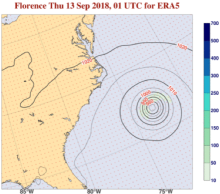 ERA5 atmospheric reanalysis
ERA5 atmospheric reanalysis
Years of record
- to
ERA5, the successor to ERA-Interim, provides global, hourly estimates of atmospheric, ocean-wave and land-surface variables, at a horizontal resolution of 31 km and 137 levels in the vertical from the surface to 0.01 hPa (about 80km). Produced by ECMWF on behalf of the European Union’s Copernicus Climate Change Service (C3S), ERA5 extends from 1940 onwards. Each day one…
-
Timestep
- Sub-daily, Daily, Monthly
-
Domain
- Global
-
Collections
- Diagnostic Data Sets
Experts contributing reviews
- Hersbach, Hans
 Extended Edited Synoptic Cloud Reports Archive (EECRA) from Ships and Land Stations Over the Globe
Extended Edited Synoptic Cloud Reports Archive (EECRA) from Ships and Land Stations Over the Globe
Years of record
- to
"The Extended Edited Synoptic Cloud Reports Archive makes use of routine synoptic observations made by humans on ships over the ocean and at weather stations over land. Following the synoptic code (WMO, 1974), observers report the fraction of sky dome covered by all clouds, the fraction of sky dome covered by clouds in the lowest layer, the cloud type at low, mid, and…
Experts contributing reviews
- Norris, Joel
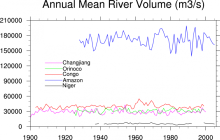 Freshwater Discharge: 1948-2004
Freshwater Discharge: 1948-2004
Years of record
- to
"A dataset of historical monthly streamflow at the farthest downstream stations for the world’s 925 largest ocean-reaching rivers has been created for community use. Compared with previous studies, the new dataset has improved homogeneity and enables more reliable assessments of decadal and long-term changes in continental freshwater discharge into the oceans." The data…
-
Timestep
- Monthly
-
Domain
- Global
-
Collections
- Climate Analysis Section (CAS) Data Catalog
Experts contributing reviews
- N/A
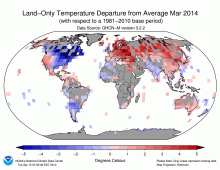 GHCN (Global Historical Climatology Network) Related Gridded Products
GHCN (Global Historical Climatology Network) Related Gridded Products
Years of record
- to
Long time series of gridded surface temperature and precipitation data derived from homongenized station data. The gridded anomalies were produced from GHCN-M bias corrected data. GHCN data and CAMS (Climate Anomaly Monitoring System) are combined to produce a high resolution 'real-time' product.
Main variables and Earth System components
N/AExperts contributing reviews
- N/A
 GHCN-D: Global Historical climatology Network daily temperatures
GHCN-D: Global Historical climatology Network daily temperatures
Years of record
- to
The Global Historical Climatology Network Daily database, GHCN-D, contains meteorological measurements from over 90,000 stations across the globe. The majority of station records contain precipitation data only, however other key variables including maximum temperature, minimum temperature, snowfall, cloudiness, wind speed and snow depth are available at many…
Main variables and Earth System components
Atmosphere Maximum Air Temperature Minimum Air Temperature PrecipitationExperts contributing reviews
- McKinnon, Karen
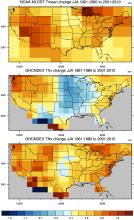 GHCNDEX: Gridded Temperature and Precipitation Climate Extremes Indices (CLIMDEX data)
GHCNDEX: Gridded Temperature and Precipitation Climate Extremes Indices (CLIMDEX data)
Years of record
- to
GHCNDEX provides gridded, station-based indices of temperature- and precipitation- related climate extremes. It is intended for detection and attribution studies, climate model evaluation, and operational monitoring of extreme climatic events. Twenty-six indices, including daily maximum and minimum temperatures, number of frost days, maximum 1-day precipitation, and…
Main variables and Earth System components
Atmosphere Maximum Air Temperature Minimum Air Temperature Land Freeze/ThawExperts contributing reviews
- N/A
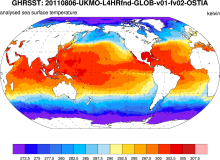 GHRSST: Group for High Resolution Sea Surface Temperature
GHRSST: Group for High Resolution Sea Surface Temperature
Years of record
- to
The Group for High-Resolution Sea Surface Temperature (SST; GHRSST) provides a new generation of global high-resolution (10km) SST products to the operational oceanographic, meteorological, climate and general scientific community. The products are provided at a variety of processing levels including "gap-free" global grids. Each SST grid point must have associated with…
Experts contributing reviews
- N/A
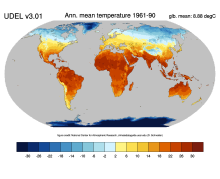 Global (land) precipitation and temperature: Willmott & Matsuura, University of Delaware
Global (land) precipitation and temperature: Willmott & Matsuura, University of Delaware
Years of record
- to
A series of gridded temperature and precipitation data sets. Station records that served as bases for the Terrestrial Air Temperature: 1900-2014 Gridded Monthly Time Series (Version 4.01) and Terrestrial Precipitation: 1900-2014 Gridded Monthly Time Series (Version 4.01) archives are used here to help create new gridded climatologies of monthly and annual average air…
Main variables and Earth System components
Atmosphere Air Temperature Air Temperature at 2m Precipitation-
Timestep
- Climatology, Monthly
-
Domain
- Global
-
Collections
- Diagnostic Data Sets, NCAR-DOE-CESM, atmosdiagnostics
Experts contributing reviews
- Matsuura, Kenji
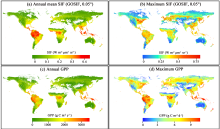 Global dataset of solar-induced chlorophyll fluorescence (GOSIF)
Global dataset of solar-induced chlorophyll fluorescence (GOSIF)
Years of record
- to
GOSIF is a global, gridded dataset of solar-induced chlorophyll fluorescence (SIF). SIF, an energy flux re-emitted by plants a few nanoseconds after light absorption, exhibits a strong linear relationship with gross primary production (GPP) at the ecosystem scale and thereby is a strong proxy of GPP. The GOSIF dataset (Li and Xiao, 2019a) provides 8-day SIF data…
Main variables and Earth System components
Biosphere GPP: Gross Primary Production solar-induced chlorophyll fluorescence (SIF) Land Gross Primary Production-
Formats
- N/A
-
Timestep
- Monthly, Weekly
-
Domain
- Global
-
Collections
- N/A
Experts contributing reviews
- Xiao, Jingfeng, Li, Xing
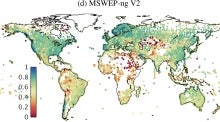 Global high-resolution precipitation: MSWEP
Global high-resolution precipitation: MSWEP
Years of record
- to
Multi-Source Weighted-Ensemble Precipitation (MSWEP) is a sub-daily precipitation dataset with full global coverage at 0.1° resolution, spanning the period 1979 to present. It is updated in near real-time with a latency of three hours, making it suitable for operational applications and for taking a quick look at recent anomalous precipitation events and placing…
Experts contributing reviews
- Beck, Hylke
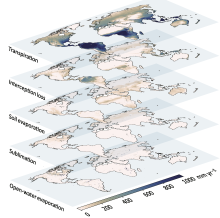 Global Land Evaporation Amsterdam Model (GLEAM)
Global Land Evaporation Amsterdam Model (GLEAM)
Years of record
- to
The Global Land Evaporation Amsterdam Model (GLEAM) is a satellite remote sensing-based set of algorithms dedicated to the estimation of evaporation and soil moisture at global scales (Miralles et al. 2011). The current version of GLEAM (version 3) operates at a daily time step with a spatial resolution of 0.25 degrees (Martens et al. 2017). The dataset consists of two…
Main variables and Earth System components
Biosphere land evaporation Land evapotranspiration Soil Moisture-
Formats
- N/A
-
Timestep
- Daily
-
Domain
- Global
-
Collections
- N/A
Experts contributing reviews
- Miralles, Diego, Koppa, Akash
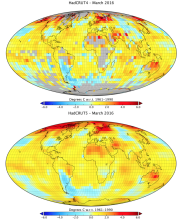 Global land-ocean surface temperature data: HadCRUT5
Global land-ocean surface temperature data: HadCRUT5
Years of record
- to
HadCRUT5 is one of the main datasets used to monitor global and regional surface temperature variability and trends. It is a global surface temperature product that combines land surface air temperatures from CRUTEM5 with SSTs from HadSST4. HadCRUT5 is a departure from its predecessors (HadCRUT4, HadCRUT3, etc.) in that two different versions are offered. Both versions…
Main variables and Earth System components
Atmosphere Air Temperature at 2m Ocean SST - sea surface temperature-
Formats
- netCDF
-
Timestep
- Monthly
-
Domain
- Global
-
Collections
- Diagnostic Data Sets
Experts contributing reviews
- Hausfather, Zeke
 Global Mean Sea Level from TOPEX & Jason Altimetry
Global Mean Sea Level from TOPEX & Jason Altimetry
Years of record
- to
The global mean sea level timeseries is an excellent, integrative indicator of long-term global temperature trends, providing a record that is observed and processed independent of common metrics like global surface air temperature. The major contributions to the observed sea level trend of 3.3 mm/year include the ocean's thermal expansion, meltwater from mountain…
Experts contributing reviews
- Nerem, R.S.
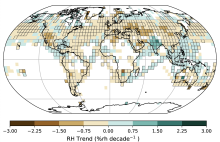 Global near-surface humidity data: HadISDH
Global near-surface humidity data: HadISDH
Years of record
- to
HadISDH (Met Office Hadley Centre International Surface Dataset of Humidity) is a gridded 5°x5° monthly mean product beginning in January 1973, and updated annually. It provides monthly gridded specific humidity (q), relative humidity (RH), vapor pressure (e), dew point temperature (Td), wet-bulb temperature (Tw), dew point depression (DPD), equivalent temperature (Te…
Main variables and Earth System components
Atmosphere Air Temperature at 2m Relative Humidity Specific HumidityExperts contributing reviews
- Willett, Kate
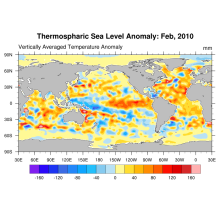 Global Ocean Heat and Thermospheric Sea Level Change
Global Ocean Heat and Thermospheric Sea Level Change
Years of record
- to
Using updated data from the World Ocean Database (Boyer et al, 2009) and improved ARGO profiling data, new estimates of ocean heat content and thermospheric sea level change (0-2000m) for the period 1955-2010 are derived.
Experts contributing reviews
- N/A
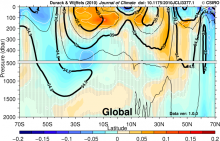 Global Ocean Salinity Change, 1950-2008 (Durack-Wijffels)
Global Ocean Salinity Change, 1950-2008 (Durack-Wijffels)
Years of record
- to
Using data from the Indian Ocean Hydrobase (IOHB) (Kobayashi et al., 2006), Hydrobase2 (Curry, 2002), and Southern Ocean Atlas (Orsi and Whitworth, 2010) databases along with the improved spatial and temporal coverage provided by ARGO profiling data, new estimates of ocean salinity and temperature change (0-2000m) for the period 1950-2008 are derived. The data have been…
Main variables and Earth System components
N/AExperts contributing reviews
- N/A
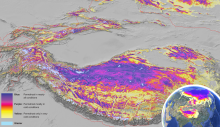 Global Permafrost Zonation Index Map
Global Permafrost Zonation Index Map
Years of record
- N/A
This data set contains a global (excluding Antarctica) 1 km map of permafrost zonation. It is an estimate of to what degree permafrost exists in a region nearly everywhere, or only in the most favorable conditions. These local conditions affecting permafrost occurrence will partly exhibit regional trends (e.g. mean snow cover characteristics or continentality), partly…
Experts contributing reviews
- Gruber, Stephan
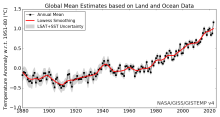 Global surface temperature data: GISTEMP: NASA Goddard Institute for Space Studies (GISS) Surface Temperature Analysis
Global surface temperature data: GISTEMP: NASA Goddard Institute for Space Studies (GISS) Surface Temperature Analysis
Years of record
- to
NASA Goddard's Global Surface Temperature Analysis (GISTEMP) combines land surface air temperatures from GHCN-M version 4 with SSTs of the ERSSTv5 analysis into a comprehensive, global surface temperature data set spanning 1880 to the present at monthly resolution, on a 2x2 degree latitude-longitude grid. As such, it is one of the main data sets used to monitor global…
Main variables and Earth System components
Atmosphere Air Temperature Ocean SST - sea surface temperature-
Timestep
- Monthly
-
Domain
- Global
Experts contributing reviews
- Lenssen, Nathan
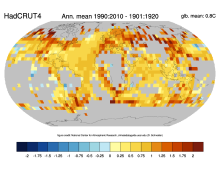 Global surface temperature data: HadCRUT4 and CRUTEM4
Global surface temperature data: HadCRUT4 and CRUTEM4
Years of record
- to
Extending back to 1850 and frequently updated, HadCRUT4 is the longest data set of its type. HadCRUT4 is a combination of the global land surface temperature data set, CRUTEM4 and the global SST data set, HadSST3. HadCRUT4 is different from the most closely comparable products (e.g. NASA GISTEMP and NOAA MLOST) in that no interpolation is performed. As such, there are…
Main variables and Earth System components
Atmosphere Air Temperature Ocean SST - sea surface temperature-
Timestep
- Climatology, Monthly
-
Domain
- Global
Experts contributing reviews
- N/A
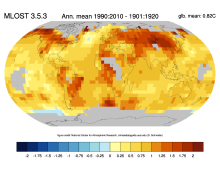 Global surface temperature data: MLOST: NOAA Merged Land-Ocean Surface Temperature Analysis
Global surface temperature data: MLOST: NOAA Merged Land-Ocean Surface Temperature Analysis
Years of record
- to
NOAA's Merged Land-Ocean Surface Temperature Analysis (MLOST) combines land surface air temperatures primarily from the Global Historical Climatology Network, Monthly (GHCN-M) version 3 with SSTs of the ERSSTv3b analysis into a comprehensive global surface temperature data set spanning 1880 to the present at monthly resolution, on a 5x5 degree latitude-longitude grid.…
Main variables and Earth System components
Atmosphere Air Temperature Ocean SST - sea surface temperature-
Timestep
- Monthly
-
Domain
- Global
Experts contributing reviews
- N/A
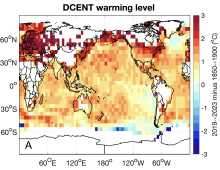 Global surface temperature data: The Dynamically Consistent ENsemble of Temperature (DCENT)
Global surface temperature data: The Dynamically Consistent ENsemble of Temperature (DCENT)
Years of record
- to
The Dynamically Consistent ENsemble of Temperature (DCENT) provides monthly, global, gridded, surface temperature anomalies since 1850. This product provides combined land surface air temperature (LSAT) and sea surface temperature (SST) anomalies at monthly 5° x 5° resolution. An important feature of DCENT is that both land and ocean measurements are used when bias-…
Main variables and Earth System components
Atmosphere Air Temperature at 2m Ocean SST - sea surface temperatureExperts contributing reviews
- Chan, Duo
 Global surface temperature: Maximum Likelihood Estimates of Temperatures using HadCRUT5 (Version 1.2)
Global surface temperature: Maximum Likelihood Estimates of Temperatures using HadCRUT5 (Version 1.2)
Years of record
- to
The Maximum Likelihood Estimates of Temperatures using HadCRUT5 Version 1.2 (HadCRU_MLE_v1.2) dataset provides global complete surface temperature estimates since 1850, with monthly 5°x5° resolution. It uses more sophisticated statistical models to fill data gaps in the non-infilled version of HadCRUT5. The statistical models used in HadCRU_MLE_v1.2 better…
Main variables and Earth System components
Atmosphere Air Temperature at 2m Ocean SST - sea surface temperatureExperts contributing reviews
- Chan, Duo
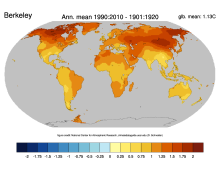 Global surface temperatures: BEST: Berkeley Earth Surface Temperatures
Global surface temperatures: BEST: Berkeley Earth Surface Temperatures
Years of record
- to
The Berkeley Earth Surface Temperatures (BEST) are a set of data products, originally a gridded reconstruction of land surface air temperature records spanning 1701-present, and now including an 1850-present merged land-ocean data set that combines the land analysis with an interpolated version of HadSST3. The land station data are available in an archive, and…
Main variables and Earth System components
Atmosphere Air Temperature Maximum Air Temperature Minimum Air Temperature Ocean SST - sea surface temperatureExperts contributing reviews
- Cowtan, Kevin
 Global Temperature Data Sets: Overview & Comparison Table
Global Temperature Data Sets: Overview & Comparison Table
Years of record
- to
Global surface temperature data sets are an essential resource for monitoring and understanding climate variability and long-term trends. The most commonly used data sets combine historical observations of near surface air temperatures at land stations with global data sets of sea surface temperatures (SST) obtained from a changing mix of ship-based and buoy…
Main variables and Earth System components
Atmosphere Air Temperature Air Temperature at 2m Ocean SST - sea surface temperature-
Timestep
- Climatology, Monthly
-
Domain
- Global
-
Collections
- Overview / Comparison page
Experts contributing reviews
- N/A
 Global-mean methane at the Earth's surface from NOAA’s global cooperative greenhouse gas measurements
Global-mean methane at the Earth's surface from NOAA’s global cooperative greenhouse gas measurements
Years of record
- to
NOAA’s Global Monitory Laboratory has measured atmospheric methane levels since 1983 at a global cooperative greenhouse gases sampling network, which currently includes more than 50 sites. This measurement network is unique among greenhouse gases monitoring programs with its global coverage and long-term records. It aims to track the atmospheric abundances of long-lived…
Experts contributing reviews
- Lan, Xin
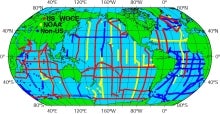 GLODAP: GLobal Ocean Data Analysis Project for Carbon
GLODAP: GLobal Ocean Data Analysis Project for Carbon
Years of record
- N/A
The GLobal Ocean Data Analysis Project (GLODAP) is a cooperative effort to coordinate global synthesis projects funded through the National Oceanic and Atmospheric Administration (NOAA), the U.S. Department of Energy (DOE), and the National Science Foundation (NSF) as part of the Joint Global Ocean Flux Study - Synthesis and Modeling Project (JGOFS-SMP). Cruises…
-
Timestep
- Climatology
-
Domain
- Global
-
Collections
- Carbon cycle
Experts contributing reviews
- N/A
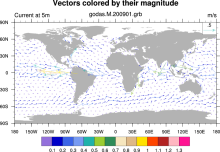 GODAS: NCEP Global Ocean Data Assimilation System
GODAS: NCEP Global Ocean Data Assimilation System
Years of record
- to
GODAS is a real-time ocean analysis and a reanalysis. It is used for monitoring, retrospective analysis as well as for providing oceanic initial conditions for the CFS. Both temperature and synthetic salinity profiles are assimilated in a 3DVAR scheme. Beginning with March 2007, altimetry sea level is assimilated.
Main variables and Earth System components
Ocean 3D Velocity SST - sea surface temperature Salinity heat flux isothermal layer depth mixed layer depth potential temperature salt flux sea surface height-
Timestep
- Monthly, Pentad
-
Domain
- Global
-
Collections
- Climate Analysis Section (CAS) Data Catalog
Experts contributing reviews
- N/A
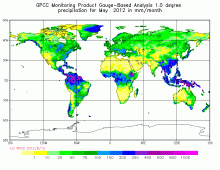 GPCC: Global Precipitation Climatology Centre
GPCC: Global Precipitation Climatology Centre
Years of record
- to
The GPCC provides gridded gauge-analysis products derived from quality controlled station data. Two products are for climate: (a) the Full Data Reanalysis Product (1901-2010) is recommended for global and regional water balance studies, calibration/validation of remote sensing based rainfall estimations and verification of numerical models, and (b) the VASClimO 50…
-
Timestep
- Climatology, Daily, Monthly
-
Domain
- Global
Experts contributing reviews
- N/A
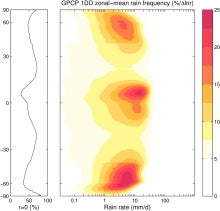 GPCP (Daily): Global Precipitation Climatology Project
GPCP (Daily): Global Precipitation Climatology Project
Years of record
- to
The 1DD product provides precipitation estimates on a 1-degree grid over the entire globe at 1-day (daily) for the period October 1996 - present. Both the Pentad and 1DD products are consistent with the Version 2 monthly product in the sense that the Pentad and 1DD approximately sum to the monthly SG estimate. All three precipitation products are produced by optimally…
Experts contributing reviews
- Pendergrass, Angeline
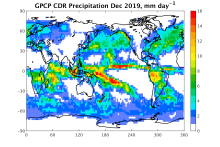 GPCP (Monthly): Global Precipitation Climatology Project
GPCP (Monthly): Global Precipitation Climatology Project
Years of record
- to
Data from rain gauge stations, satellites, and sounding observations have been merged to estimate monthly rainfall on a 2.5-degree global grid from 1979 to the present. The careful combination of satellite-based rainfall estimates provides the most complete analysis of rainfall available to date over the global oceans, and adds necessary spatial detail to the rainfall…
-
Timestep
- Climatology, Monthly
-
Domain
- Global
Experts contributing reviews
- Pendergrass, Angeline, Wang, Jian-Jian
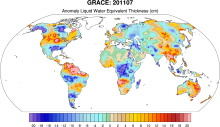 GRACE: Gravity Recovery and Climate Experiment: Surface mass, total water storage, and derived variables
GRACE: Gravity Recovery and Climate Experiment: Surface mass, total water storage, and derived variables
Years of record
- to
The Gravity Recovery and Climate Experiment (GRACE) refers to a pair of NASA satellites that has flown in low-Earth orbit since 2002. The satellites use a precise microwave ranging system to measure the distance between themselves due to gravitational acceleration. Onboard GPS instruments determine the exact position of the satellites over the Earth. GRACE measures…
Main variables and Earth System components
Cryosphere Glaciers Ice Sheet Mass Land Groundwater surface water Water Storage Ocean Bottom pressure-
Timestep
- Daily, Monthly
-
Domain
- Global
-
Collections
- Diagnostic Data Sets, NCAR-DOE-CESM, landdiagnostics, landicediagnostics
Experts contributing reviews
- Swenson, Sean
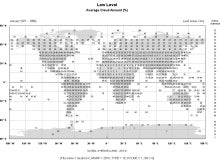 Gridded Climatology of Clouds from Surface Observations Worldwide (1971-2008)
Gridded Climatology of Clouds from Surface Observations Worldwide (1971-2008)
Years of record
- to
This digital archive provides multi-year monthly, seasonal, and annual averages in 5x5-degree grid boxes (or 10x10-degree boxes for some quantities over the ocean). Daytime and nighttime averages, as well as the diurnal average (average of day and night), are given. Nighttime averages were computed using only those reports that met an "illuminance criterion" (i.e., made…
-
Formats
- ascii
-
Timestep
- Climatology, Monthly, Seasonal
-
Domain
- Global
-
Collections
- Diagnostic Data Sets, NCAR-DOE-CESM, atmosdiagnostics
Experts contributing reviews
- Norris, Joel
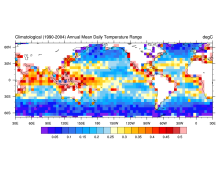 HadDTR: Hadley Centre sea-surface temperature diurnal temperature range climatology
HadDTR: Hadley Centre sea-surface temperature diurnal temperature range climatology
Years of record
- N/A
The Hadley Centre sea-surface temperature diurnal temperature range climatology is a 5x5 degree gridded climatology of the diurnal range of sea surface temperature as measured by drifting buoys.
Experts contributing reviews
- N/A
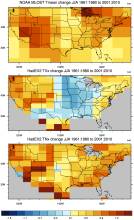 HadEX2: Gridded Temperature and Precipitation Climate Extremes Indices (CLIMDEX data)
HadEX2: Gridded Temperature and Precipitation Climate Extremes Indices (CLIMDEX data)
Years of record
- to
Note: HadEX2 has been superseded by HadEX3. HadEX2 provides gridded, station-based indices of temperature- and precipitation- related climate extremes. It is intended for detection and attribution studies and climate model evaluation. Twenty-nine indices, including daily maximum and minimum temperatures, number of frost days, maximum 1-day precipitation, and growing…
Main variables and Earth System components
Atmosphere Maximum Air Temperature Minimum Air Temperature Land Freeze/ThawExperts contributing reviews
- N/A
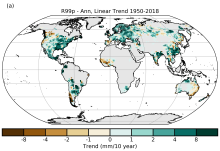 HadEX3: Gridded Temperature and Precipitation Climate Extremes Indices (CLIMDEX data)
HadEX3: Gridded Temperature and Precipitation Climate Extremes Indices (CLIMDEX data)
Years of record
- to
HadEX3 provides gridded, station-based indices of temperature- and precipitation- related climate extremes and supersedes HadEX2. It is intended for global and continental climate monitoring, detection and attribution studies and climate model evaluation. Twenty-nine indices, including daily maximum and minimum temperatures, number of frost days, maximum 1-day…
Main variables and Earth System components
Atmosphere Air Temperature at 2m Maximum Air Temperature Minimum Air Temperature Land Freeze/ThawExperts contributing reviews
- Dunn, Robert
 HadGHCNDEX - Gridded Daily Temperature Extremes
HadGHCNDEX - Gridded Daily Temperature Extremes
Years of record
- to
HadGHCND (aka HadGHCNDEX) is a gridded daily dataset of near-surface maximum (TX) and minimum (TN) temperature observations. Anomalies (departures from 1961-1990 climatology) and actual temperatures are distributed in two separate files. The dataset is designed primarily for the analysis of climate extremes and also for climate model evaluation. It spans the years 1950…
Main variables and Earth System components
Atmosphere Maximum Air Temperature Minimum Air TemperatureExperts contributing reviews
- N/A
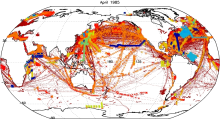 HadIOD: Met Office-Hadley Centre Integrated Ocean Database
HadIOD: Met Office-Hadley Centre Integrated Ocean Database
Years of record
- to
HadIOD (Met Office Hadley Centre Integrated Ocean Database) is a global database of in situ ocean temperature and salinity observations, spanning 1850-present on a daily timestep. It is somewhat unique among temperature and salinity datasets in that it combines observations from both surface and sub-surface observing platforms. As such, it is well suited to activities…
Main variables and Earth System components
Ocean Salinity SST - sea surface temperature Sub Surface TemperatureExperts contributing reviews
- Atkinson, Chris
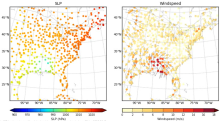 HadISD: Sub-daily, non-interpolated weather station data
HadISD: Sub-daily, non-interpolated weather station data
Years of record
- to
HadISD ("Hadley Centre Integrated Surface Database") is a compendium of subdaily weather-station data developed by the UK Met Office that is based on NOAA NCEI's Integrated Surface Database but with various quality-control checks implemented to remove stations with excessive and obvious typographical or instrumental errors, as well as individual occurrences of these…
Main variables and Earth System components
Atmosphere Air Temperature at 2m Dew Point Temperature Precipitation Sea Level Pressure Storm data WindExperts contributing reviews
- Raymond, Colin
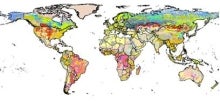 Harmonized Soil Carbon Database
Harmonized Soil Carbon Database
Years of record
- N/A
"This state-of-the-art database was established by IIASA and FAO in partnership with: ISRIC-World Soil Information which, together with the FAO, contributed recent regional soil and terrain databases together with the WISE soil profile database; The European Soil Bureau Network, which provided its major new update of soil information for Europe and northern Eurasia;…
-
Formats
- netCDF, ARC/INFO ASCII GRID
-
Timestep
- N/A
-
Domain
- Global
-
Collections
- Carbon cycle
Experts contributing reviews
- N/A
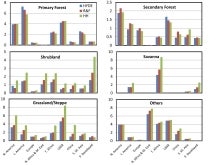 Historical land-cover changes and land-use conversions global data set by Meiyappan and Jain
Historical land-cover changes and land-use conversions global data set by Meiyappan and Jain
Years of record
- to
A set of three estimates of land-cover types and annual transformations of land use are provided on a global 0.5°x0.5° grid at annual timesteps. The longest of the three estimates spans 1770-2010. The three estimates use three different data sets of cropland and pastureland. Common input data sets are of wood harvest and urban land. The three estimates use a consistent…
Main variables and Earth System components
Land Land Cover Type Land Use Conversion Vegetation CoverExperts contributing reviews
- Meiyappan, Prasanth
 HOAPS: Hamburg Ocean Atmosphere Parameters and Fluxes from Satellite Data
HOAPS: Hamburg Ocean Atmosphere Parameters and Fluxes from Satellite Data
Years of record
- to
The Hamburg Ocean Atmosphere Parameters and Fluxes from Satellite Data (HOAPS) set is a satellite-based climatology of precipitation, evaporation and freshwater budget (evaporation minus precipitation) as well as related turbulent heat fluxes and atmospheric state variables over the global ice free oceans. All variables are derived from SSM/I passive microwave…
Main variables and Earth System components
Atmosphere Evaporation Evaporation-Precipitation Precipitation Radiation Specific Humidity Wind Latent & sensible heat flux Precipitable water Ocean SST - sea surface temperature-
Formats
- netCDF
-
Timestep
- Climatology, Sub-daily, Monthly, Pentad
-
Domain
- Global
-
Collections
- Boundary Conditions
Experts contributing reviews
- N/A
 IBTrACS: Tropical cyclone best track data
IBTrACS: Tropical cyclone best track data
Years of record
- N/A
IBTrACS (International Best Track Archive for Climate Stewardship) provides global tropical cyclone best track data in a centralized location to aid our understanding of the distribution, frequency, and intensity of tropical cyclones worldwide. The World Meteorological Organization Tropical Cyclone Programme has endorsed IBTrACS as an official archiving and distribution…
Experts contributing reviews
- Schreck, Carl
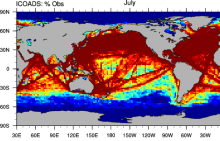 ICOADS Surface Marine Weather Observations
ICOADS Surface Marine Weather Observations
Years of record
- N/A
ICOADS (International Comprehensive Ocean-Atmosphere Data Set) is the most comprehensive archive of global marine surface climate observations available. Variables include SST, SLP, air temperature, wind speed, cloud amount, and others. There is no processing beyond initial quality control. ICOADS data are packaged in several different formats with different time…
Main variables and Earth System components
Atmosphere Air Temperature Budget Cloud Properties Latent & sensible heat flux Sea Level Pressure Specific Humidity Wind Ocean SST - sea surface temperatureExperts contributing reviews
- Deser, Clara
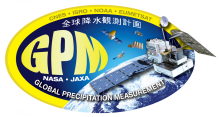 IMERG precipitation algorithm and the Global Precipitation Measurement (GPM) Mission
IMERG precipitation algorithm and the Global Precipitation Measurement (GPM) Mission
Years of record
- to
IMERG (Integrated Multi-satellitE Retrievals for the Global Precipitation Measurement) is NASA's updated precipitation algorithm, while the Global Precipitation Measurement (GPM) mission is an international satellite mission launched by NASA and JAXA on Feb. 27, 2014. The GPM is a follow on to the TRMM satellite mission. NASA have applied the IMERG algorithm to both…
Experts contributing reviews
- Huffman, George J., Tan, Jackson
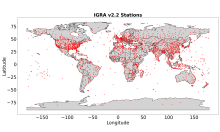 Integrated Global Radiosonde Archive (IGRA)
Integrated Global Radiosonde Archive (IGRA)
Years of record
- to
The largest publicly available collection of quality-controlled, globally-distributed, historical radiosonde and pilot balloon observations is the Integrated Global Radiosonde Archive (IGRA; Durre et al. 2006, 2018). First released in 2004, IGRA is maintained and distributed by NOAA’s National Centers for Environmental Information (NCEI). IGRA v2.2, which was released…
Main variables and Earth System components
Atmosphere Dew Point Temperature Geopotential Height Multiple variables Relative Humidity WindExperts contributing reviews
- Durre, Imke, Korzeniewski, Bryant
 ISCCP: International Satellite Cloud Climatology Project
ISCCP: International Satellite Cloud Climatology Project
Years of record
- to
The International Satellite Cloud Climatology Project (ISCCP) makes use of routine observations by operational weather satellites to provide a long-term (1983-2009), gridded, global record of cloud properties. ISCCP uses observations in the visible and infrared window portions of the spectrum to determine cloud optical thickness and cloud top temperature, from which the…
-
Timestep
- Climatology, Sub-daily, Monthly
-
Domain
- Global
Experts contributing reviews
- Pincus, Robert
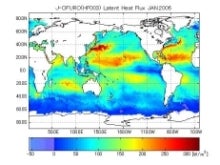 Japanese Ocean Flux Data sets with Use of Remote Sensing Observations (J-OFURO2)
Japanese Ocean Flux Data sets with Use of Remote Sensing Observations (J-OFURO2)
Years of record
- to
These ocean surface flux data sets are derived primarily using data from multiple satellites. The COARE 3.0 bulk algorithm [Fairall et al. (2003)] is used in J-OFURO2 for the estimation of sensible and latent heat fluxes.
Main variables and Earth System components
Atmosphere Specific Humidity Wind Stress Latent & sensible heat flux Ocean Surface FluxExperts contributing reviews
- N/A
 JRA-55
JRA-55
Years of record
- to
Spanning 1958-present, JRA-55 is the longest third-generation reanalysis that uses the full observing system (in contrast, products like ERA-20C and NOAA 20CR assimilate a very limited set of observations while NCEP R1 uses an antiquated model and assimilation scheme). Compared to the previous generation Japanese Meteorological Agency (JMA) reanalysis, JRA-25, JRA…
Main variables and Earth System components
Atmosphere Air Temperature Geopotential Height Precipitable waterExperts contributing reviews
- Kobayashi, Shinya
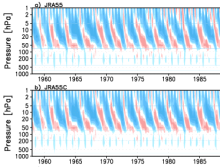 JRA-55C (reanalysis using conventional observations)
JRA-55C (reanalysis using conventional observations)
Years of record
- to
JRA-55C is a fixed observing system atmospheric reanalysis that uses the same model and data assimilation scheme as JRA-55. The observations assimilated include surface station data, radiosondes, tropical cyclone retrievals and wind profilers. No satellite observations are included. JRA-55C spans November, 1972 thru December, 2012 but may be extended back to…
Main variables and Earth System components
N/AExperts contributing reviews
- Kobayashi, Chiaki
 Kaplan Sea Surface Temperature Anomalies
Kaplan Sea Surface Temperature Anomalies
Years of record
- to
The most up-to-date version is known as Kaplan Extended SST v2, which combines statistically infilled grids of UK Met Office SSTs for 1856-1981 with a statistically reduced and coarser resolution version of Smith and Reynolds Optimally Interpolated (OI) SSTs for 1981 to present. Those desiring only recent data should use another product.
Experts contributing reviews
- Kaplan, Alexy
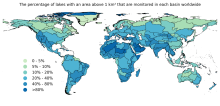 Lake Water Storage: GloLakes
Lake Water Storage: GloLakes
Years of record
- to
Lakes and reservoirs are critical components of the hydrological cycle, particularly due to their central role in many human systems. Long-term measurements of lakes is critical for understanding the dynamics linking lake volume to the climate system and human activities. The GloLakes dataset utilities remote sensing data to provide near real-time monitoring of the…
-
Formats
- N/A
-
Timestep
- Monthly
-
Domain
- Global
-
Collections
- BAMS State of the Climate
Experts contributing reviews
- N/A
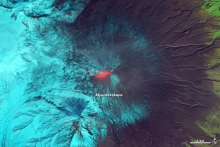 LANDSAT
LANDSAT
Years of record
- to
"The Landsat Program provides the longest continuous space-based record of Earth’s land in existence. Since 1972, Landsat satellites have collected measurements of Earth’s continents and surrounding coastal regions that have enabled people to study forests, food production, water and land use, ecosystems, geology, and more. The long data record allows scientists to…
Main variables and Earth System components
Biosphere NPP: Net Primary Production Land Land Cover Type Vegetation Cover-
Formats
- N/A
-
Timestep
- Sub-daily
-
Domain
- Global
-
Collections
- Carbon cycle
Experts contributing reviews
- N/A
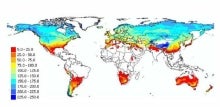 Landscape surface freeze/thaw status based on passive microwave remote sensing
Landscape surface freeze/thaw status based on passive microwave remote sensing
Years of record
- to
A global data set of the frozen state of the land surface (free-thaw (FT) status) has been developed spanning 1979-present at a daily timestep and 25 x 25 km spatial resolution. Based on passive microwave remote sensing, the FT parameter is closely related to the surface energy budget, hydrologic cycle, trace gas exchanges, vegetation growth, and terrestrial carbon…
-
Timestep
- Daily
-
Domain
- Global
-
Collections
- Climate Data Record
Experts contributing reviews
- Kimball, John
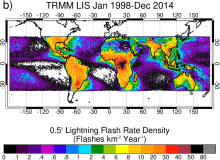 Lightning data from the TRMM and ISS Lightning Image Sounder (LIS): Towards a global lightning Climate Data Record
Lightning data from the TRMM and ISS Lightning Image Sounder (LIS): Towards a global lightning Climate Data Record
Years of record
- to
The Lightning Imaging Sensor (LIS) is an optically based spaceborne lightning detection instrument that has been hosted on two different platforms – the Tropical Rainfall Measuring Mission satellite (TRMM; 1998-2015; Kummerow et al. 1998) and the International Space Station (ISS; 2017-present; Blakeslee et al. 2020). Relative to TRMM LIS, which covered ±38 latitude, ISS…
Experts contributing reviews
- Lang, Timothy
 Merged Hadley-NOAA/OI Sea Surface Temperature & Sea-Ice Concentration (Hurrell et al, 2008)
Merged Hadley-NOAA/OI Sea Surface Temperature & Sea-Ice Concentration (Hurrell et al, 2008)
Years of record
- to
The merged Hadley-OI sea surface temperature (SST) and sea ice concentration (SIC) data sets were specifically developed as surface forcing data sets for AMIP style uncoupled simulations of the Community Atmosphere Model (CAM). The Hadley Centre's SST/SIC version 1.1 (HADISST1), which is derived gridded, bias-adjusted in situ observations, were merged with the NOAA-…
Main variables and Earth System components
Cryosphere Sea Ice Concentration Ocean SST - sea surface temperature-
Formats
- netCDF
-
Timestep
- Monthly
Experts contributing reviews
- N/A
 MODIS GPP/NPP Project (MOD17)
MODIS GPP/NPP Project (MOD17)
Years of record
- to
The goal of the MOD17 MODIS project is to provide continuous estimates of Gross/Net Primary Production (GPP/NPP) across Earth’s entire vegetated land surface. MOD17 GPP/NPP outputs are useful for natural resource and land management, global carbon cycle analysis, ecosystem status assessment, and environmental change monitoring. MOD17 is part of the NASA Earth…
Experts contributing reviews
- N/A
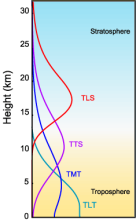 MSU/AMSU Atmospheric Temperature Climate Data Record, Remote Sensing Systems (RSS)
MSU/AMSU Atmospheric Temperature Climate Data Record, Remote Sensing Systems (RSS)
Years of record
- to
A long (30-year+) data set of atmospheric temperatures for 4 tropopsheric and lower stratopsheric layers has been derived from brightness temperatures measured by the Microwave Sounding Unit (MSU) and Advanced Microwave Sounding Unit (AMSU). This page describes the data sets developed by Remote Sensing Systems (RSS); other options exist for comparisons. One of the most…
-
Timestep
- Monthly
-
Domain
- Global
-
Collections
- Climate Data Record
Experts contributing reviews
- Mears, Carl
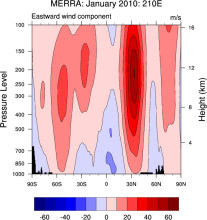 NASA MERRA
NASA MERRA
Years of record
- to
The Modern Era Retrospective-Analysis for Research and Applications (MERRA) was undertaken by NASA’s Global Modeling and Assimilation Office with two primary objectives: to place observations from NASA’s Earth Observing System satellites into a climate context and to improve upon the hydrologic cycle represented in earlier generations of reanalyses. MERRA was generated…
Main variables and Earth System components
Atmosphere Air Temperature Geopotential Height Precipitable water Water Vapor-
Timestep
- Sub-daily, Monthly
-
Domain
- Global
Experts contributing reviews
- N/A
 NASA's MERRA2 reanalysis
NASA's MERRA2 reanalysis
Years of record
- to
The Modern-Era Retrospective analysis for Research and Applications, version 2 (MERRA-2) is a global atmospheric reanalysis produced by the NASA Global Modeling and Assimilation Office (GMAO). It spans the satellite observing era from 1980 to the present. The goals of MERRA-2 are to provide a regularly-gridded, homogeneous record of the global atmosphere, and to…
Main variables and Earth System components
Atmosphere Aerosols Air Temperature Geopotential Height Precipitable waterExperts contributing reviews
- Bosilovich, Michael, Cullather, Richard
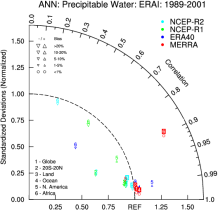 NCEP-NCAR (R1): An Overview
NCEP-NCAR (R1): An Overview
Years of record
- to
NCEP-NCAR (R1) is the original reanalysis effort. It uses a frozen global state-of-the-art global data assimilation system (as of 11 January 1995). The original database was enhanced (additional, quality checked datasets) by NCAR's Data Support Section. Originally planned to span 1957-96 ("40-Year Reanalysis Project"), it was extended back to 1948 and continues to this…
-
Timestep
- Sub-daily, Daily, Monthly
-
Domain
- Global
Experts contributing reviews
- N/A
 NDVI and EVI: Vegetation Indices (MODIS)
NDVI and EVI: Vegetation Indices (MODIS)
Years of record
- to
MODIS vegetation indices, produced on 16-day and monthly intervals and at multiple spatial resolutions, provide consistent spatial and temporal comparisons of vegetation canopy greenness, a composite property of leaf area, chlorophyll and canopy structure. Two vegetation indices are derived from atmospherically-corrected reflectance in the red, near-infrared, and blue…
Main variables and Earth System components
Land Enhanced Vegetation Index (EVI) NDVI" Normalized Difference Vegetation IndexExperts contributing reviews
- N/A
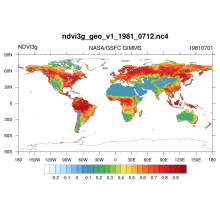 NDVI: Normalized Difference Vegetation Index-3rd generation: NASA/GFSC GIMMS
NDVI: Normalized Difference Vegetation Index-3rd generation: NASA/GFSC GIMMS
Years of record
- to
Normalized Difference Vegetation Index-3rd generation (NDVI) using the Global Inventory Monitoring and Modeling System (GIMMS): Vegetation indices are radiometric measures of photosynthetically active radiation absorbed by chlorophyll in the green leaves of vegetation canopies and are therefore good surrogate measures of the physiologically functioning surface…
Main variables and Earth System components
N/A-
Formats
- netCDF
-
Timestep
- Daily
-
Domain
- Global
-
Collections
- Climate Data Record
Experts contributing reviews
- N/A
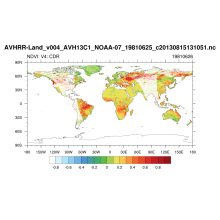 NDVI: Normalized-difference-vegetation-index: NOAA AVHRR
NDVI: Normalized-difference-vegetation-index: NOAA AVHRR
Years of record
- to
Normalized Difference Vegetation Index (NDVI) values are derived from surface reflectance data acquired by the Advanced Very High Resolution Radiometer (AVHRR) sensor. By applying knowledge gathered over time about instrument performance and sensor characteristics, the data are reprocessed to create consistent long-term records, allowing insight into changes in the…
Experts contributing reviews
- N/A
- Night Marine Air Temperature (NMAT) Datasets: CLASSnmat and UAHNMATv1
Years of record
- to
Night Marine Air Temperature (NMAT) refers to measurements of air temperature recorded with thermometers on the weather stations of ships. NMAT is a highly correlated variable with Sea Surface Temperature (SST), capturing the temperature of the atmosphere near the surface. The earliest known record of NMAT begins in 1699 with records expanding globally by the mid-1800s…
-
Formats
- netCDF
-
Timestep
- Monthly
-
Domain
- Global
-
Collections
- BAMS State of the Climate
Experts contributing reviews
- Cornes, Richard
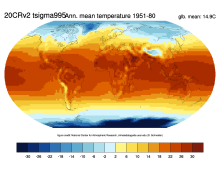 NOAA 20th-Century Reanalysis, Version 2 and 2c
NOAA 20th-Century Reanalysis, Version 2 and 2c
Years of record
- to
The Twentieth Century Reanalysis (20CR) provides a comprehensive global atmospheric circulation data set spanning 1850-2014. Its chief motivation is to provide an observational validation data set, with quantified uncertainties, for assessing climate model simulations of the 20th century, with emphasis on the statistics of daily weather. The analyses are generated by…
-
Timestep
- Sub-daily, Daily, Monthly
-
Domain
- Global
Experts contributing reviews
- N/A
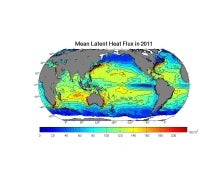 OAFlux: Objectively Analyzed air-sea Fluxes for the global oceans.
OAFlux: Objectively Analyzed air-sea Fluxes for the global oceans.
Years of record
- to
"The OAFlux project aims to provide consistent, multi-decade, global analysis of air-sea heat, freshwater (evaporation), and momentum fluxes for use in studies of global energy budget, water cycle, atmosphere and ocean circulation, and climate. The OAFlux project is so called because it applies objective analysis approach to take into account data errors in the…
Main variables and Earth System components
Atmosphere Latent & sensible heat flux Radiation Wind Ocean SST - sea surface temperature Surface Flux wind stress curlExperts contributing reviews
- N/A
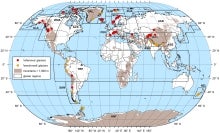 Observations of Glacier Mass Balance: The World Glacier Monitoring Service
Observations of Glacier Mass Balance: The World Glacier Monitoring Service
Years of record
- to
Mountain glaciers and ice caps have been studied as sensitive indicators of climate since the 19th century. The recognition of glacier sensitivity to climate led to the development of a global reporting system for glacier terminus change and glacier mass balance during the International Geophysical Year. The World Glacier Monitoring Service (WGMS) has been the…
-
Formats
- N/A
-
Timestep
- Annual
-
Domain
- Global
-
Collections
- BAMS State of the Climate
Experts contributing reviews
- Pelto, Mauri
 Ocean heat content for 10-1500m depth based on Argo
Ocean heat content for 10-1500m depth based on Argo
Years of record
- to
A regularly updated monthly timeseries of ocean heat content, based on Argo profiles, is integrated over 10-1500m depth and the latitudes 60°S-60°N. Coverage begins in 2005. It is estimated based on the method described in von Schuckmann and Le Traon (2011) and discussed in the context of other methods below.
Experts contributing reviews
- von Schuckmann, Karina
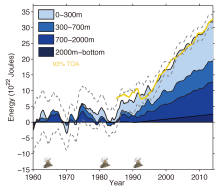 Ocean temperature analysis and heat content estimate from Institute of Atmospheric Physics
Ocean temperature analysis and heat content estimate from Institute of Atmospheric Physics
Years of record
- to
The Institute of Atmospheric Physics (IAP) ocean temperature analysis features global coverage of the oceans, at 1° x1° horizontal resolution on 41 vertical levels from 1-2000m, and monthly resolution from 1940 to present. As such, it is aimed at studies of climate variability and change, from large regional to global scales, on timescales of months to decades.…
Main variables and Earth System components
Ocean Ocean Heat Content Sea Level Sub Surface TemperatureExperts contributing reviews
- Cheng, Lijing
 ORAS4: ECMWF Ocean Reanalysis and derived ocean heat content
ORAS4: ECMWF Ocean Reanalysis and derived ocean heat content
Years of record
- to
ECMWF's current ocean reanalysis uses a sophisticated data assimilation methodology which includes a model bias correction. The ocean model used is forced by atmospheric daily surface fluxes, relaxed to SST and bias corrected. The Balmaseda et al (QJRMS 2013) reference provides excellent peer reviewed documentation and evaluation.
Main variables and Earth System components
Ocean Ocean Heat Content Salinity Sea Level potential temperature u, v current components-
Timestep
- Monthly
-
Domain
- Global
-
Collections
- Climate Analysis Section (CAS) Data Catalog
Experts contributing reviews
- N/A
 Outgoing Longwave Radiation (OLR): HIRS
Outgoing Longwave Radiation (OLR): HIRS
Years of record
- to
"The new Climate Data Record (CDR) provides daily global climate data that are valuable as inputs into Radiation Budget Studies and verifying numerical models and can identify the variations in tropical clouds and rainfall that drive global weather patterns. The daily climate data of OLR can provide radiance observations at a 1.0x1.0 Degree resolution, creating…
-
Formats
- netCDF
-
Timestep
- Daily, Monthly
-
Domain
- Global
-
Collections
- Climate Data Record
Experts contributing reviews
- N/A
 Palmer Drought Severity Index (PDSI)
Palmer Drought Severity Index (PDSI)
Years of record
- N/A
The Palmer Drought Severity Index (PDSI) uses readily available temperature and precipitation data to estimate relative dryness. It is a standardized index that generally spans -10 (dry) to +10 (wet). Maps of operational agencies like NOAA typically show a range of -4 to +4, but more extreme values are possible. The PDSI has been reasonably successful at quantifying…
-
Timestep
- Monthly
-
Domain
- Global
-
Collections
- Climate Analysis Section (CAS) Data Catalog
Experts contributing reviews
- Dai, Aiguo, Bui, Sang, Lenssen, Nathan
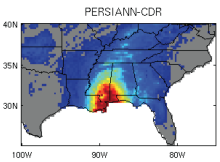 PERSIANN-CDR: Precipitation Estimation from Remotely Sensed Information using Artificial Neural Networks - Climate Data Record
PERSIANN-CDR: Precipitation Estimation from Remotely Sensed Information using Artificial Neural Networks - Climate Data Record
Years of record
- to
The Precipitation Estimation from Remotely Sensed Information using Artificial Neural Networks- Climate Data Record (PERSIANN-CDR) provides daily rainfall estimates at a spatial resolution of 0.25 degrees in the latitude band 60S - 60N from 1983 to the near-present. The precipitation estimate is produced using the PERSIANN algorithm on GridSat-B1 infrared…
-
Timestep
- Sub-daily, Daily
-
Domain
- Global
-
Collections
- Climate Data Record
Experts contributing reviews
- Ashouri, Hamed, Gehne, Maria
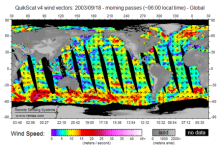 QuikSCAT: near sea-surface wind speed and direction
QuikSCAT: near sea-surface wind speed and direction
Years of record
- to
The QuikSCAT mission was intended to obtain sea-surface wind speed and direction data under all weather and cloud conditions over Earth's oceans. SeaWinds, an active radar scatterometer, is the main instrument on the QuikSCAT satellite. The microwave backscatter measured by SeaWinds is dependent on the surface roughness of the ocean, which in turn is related to wind…
Experts contributing reviews
- Ricciardulli, Lucrezia
 Radiative kernels from climate models
Radiative kernels from climate models
Years of record
- N/A
The radiative kernel technique is a method used to quantify radiative feedbacks in response to global warming. Radiative kernels are commonly calculated for the water vapor, lapse rate, temperature and albedo feedbacks. Radiative kernels are used to deconstruct the various contributions of feedbacks and forcings to the total change in top-of-atmosphere (TOA…
Main variables and Earth System components
N/AExperts contributing reviews
- Pendergrass, Angeline
 Randolph Glacier Inventory data base of global glacier outlines
Randolph Glacier Inventory data base of global glacier outlines
Years of record
- N/A
The Randolph Glacier Inventory (RGI) is a global data base of glacier outlines. It is intended for estimates of ice volume and glacier mass at regional and global scales. The data are organized into 19 large regions, with a shapefile provided for each region. The RGI is produced as part of the Global Land Ice Measurements from Space (GLIMS) initiative, a project to…
Experts contributing reviews
- N/A
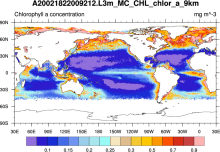 SeaWIFS: ocean bio-optical and carbon properties
SeaWIFS: ocean bio-optical and carbon properties
Years of record
- to
The purpose of the Sea-viewing Wide Field-of-view Sensor (SeaWiFS) Project is to provide quantitative data on global ocean bio-optical properties and to assess the oceans' role in the global carbon cycle. SeaWiFS data are being used to help clarify the magnitude and variability of chlorophyll and primary production by marine phytoplankton, and to determine the…
-
Formats
- HDF
-
Timestep
- Climatology, Daily, Monthly, Seasonal, Annual
-
Domain
- Global
-
Collections
- Carbon cycle
Experts contributing reviews
- N/A
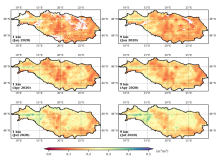 SMAP-Derived 1-km Downscaled Surface Soil Moisture
SMAP-Derived 1-km Downscaled Surface Soil Moisture
Years of record
- to
This data product contains global daily 1 km resolution surface soil moisture (SM) derived from the Soil Moisture Active Passive (SMAP) L-band radiometer observations. Specifically, Moderate Resolution Imaging Spectroradiometer (MODIS) land surface temperature and Normalized Difference Vegetation Index (NDVI) data were used with the SMAP Enhanced L2 radiometer Half-…
-
Formats
- N/A
-
Timestep
- Daily
-
Domain
- Global
-
Collections
- N/A
Experts contributing reviews
- Lakshmi, Venkataraman, Fang, Bin
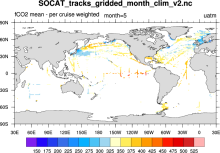 SOCAT: Surface Ocean CO2 Atlas
SOCAT: Surface Ocean CO2 Atlas
Years of record
- to
SOCAT (Surface Ocean CO2 Atlas) represents an effort to "provide a comprehensive, publicly available, regularly updated, global data set of marine surface CO2, which had been subject to quality control (QC)." The data sets are comprised of observations (ship track) and gridded data.
-
Formats
- netCDF
-
Timestep
- Climatology, Monthly, Annual
-
Domain
- Global
-
Collections
- Carbon cycle
Experts contributing reviews
- N/A
 SODA: Simple Ocean Data Assimilation
SODA: Simple Ocean Data Assimilation
Years of record
- to
The Simple Ocean Data Assimilation, or SODA, analysis is an ocean reanalysis data set consisting of gridded variables for the global ocean, as well as several derived fields. The goal is to provide an improved estimate of ocean state from those based solely on observations or numerical simulations.
Main variables and Earth System components
Wind Stress Ocean 3D Velocity potential temperature Salinity sea surface height SST - sea surface temperature u, v current componentsExperts contributing reviews
- N/A
 Speleothems and the SISAL database: An overview of the use of speleothems as archives of climate proxies
Speleothems and the SISAL database: An overview of the use of speleothems as archives of climate proxies
Years of record
- N/A
Speleothems provide globally distributed, seasonal to multi-annual resolution climate records encoded in multiple proxies including oxygen and carbon stable isotopes, and trace elements. Speleothems, such as stalagmites and flowstones, are secondary cave carbonate deposits. They grow by incremental deposition of layers of calcium carbonate from dripping water, and…
Main variables and Earth System components
N/A-
Formats
- N/A
-
Timestep
- Annual, Decadal, Irregular
-
Domain
- Global
-
Collections
- N/A
Experts contributing reviews
- Kaushal, Nikita, Lechleitner, Franziska
 SST (AMSR-E): Sea Surface Temperature from Remote Sensing Systems
SST (AMSR-E): Sea Surface Temperature from Remote Sensing Systems
Years of record
- to
High resolution (0.25°) SSTs were derived from the AMSR-E, a passive microwave radiometer flying on NASA's AQUA satellite. Remote Sensing Systems distributes the data in high spatial and temporal (daily, weekly, monthly) resolutions for both daytime and nighttime averages. Monthly versions are available on a 1°x1° grid from JPL PO-DAAC as well as the CMIP5 obs4MIPS…
Experts contributing reviews
- N/A
- SST Data Sets: Overview & Comparison Table
Years of record
- to
This overview focuses on SST datasets designed for climate applications. The focus is on datasets with coverage back to around 1850 at monthly resolution but select datasets over the satellite era that have been specifically developed as climate monitoring resources are also included. Note that information on high-resolution (10km daily or higher) operational satellite-…
-
Formats
- N/A
-
Timestep
- Climatology, Daily, Monthly, Weekly
-
Domain
- Global
-
Collections
- Overview / Comparison page
Experts contributing reviews
- Chan, Duo, Kent, Elizabeth
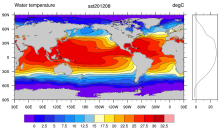 SST data: COBE: Centennial in situ Observation-Based Estimates
SST data: COBE: Centennial in situ Observation-Based Estimates
Years of record
- to
The COBE data set is a spatially complete, interpolated 1°x1° SST product for 1891 to present. It combines SSTs from ICOADS release 2.0, the Japanese Kobe collection, and reports from ships and buoys. Data are gridded using optimal interpolation. As in HadISST, data up to 1941 were bias-adjusted using the "bucket correction." Prior to the interpolation analyses, data…
Experts contributing reviews
- N/A
 SST Data: COBEv3: Centennial in situ Observation-Based Estimates Version 3
SST Data: COBEv3: Centennial in situ Observation-Based Estimates Version 3
Years of record
- to
The Centennial in situ Observation-Based Estimates of Sea Surface Temperature version 3 (COBE-SST3) is a SST analysis produced by the Japanese Meteorological Agency (JMA). The main COBE-SST3 reconstruction provides spatially complete estimates of SST over the global oceans, seas, and large lakes at daily temporal resolution on a regular 0.25° grid. The product currently…
Experts contributing reviews
- Ishii, Masayoshi
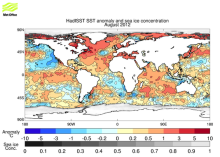 SST data: HadiSST v1.1
SST data: HadiSST v1.1
Years of record
- to
The Hadley Centre Global Sea Ice and Sea Surface Temperature (HadISST) is a combination of monthly globally complete fields of SST and sea ice concentration for 1871-present. This page focuses on the SST data; see the separate page for discussion of HadISST sea ice. HadISST uses reduced space optimal interpolation applied to SSTs from the Marine Data Bank (mainly ship…
-
Timestep
- Monthly
-
Domain
- Global
Experts contributing reviews
- N/A
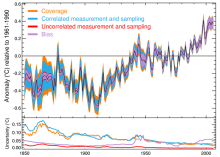 SST data: HadSST3
SST data: HadSST3
Years of record
- to
HadSST3 provides monthly SST anomalies on a 5°x5° grid for 1850-present. The anomalies are derived from a 30-year climatology spanning 1961-90.Coverage is global but there is no interpolation; Thus, missing data occur in the final product. The primary input data are from ICOADS release 2.5. Bias adjustments to the ICOADS SSTs account for changes in measurement methods (…
-
Timestep
- Monthly
-
Domain
- Global
Experts contributing reviews
- Kennedy, John
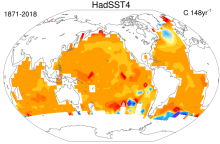 SST data: HadSST4
SST data: HadSST4
Years of record
- to
HadSST4 provides monthly SST anomalies on a 5°x5° grid for 1850-present. The anomalies are derived from a 30-year climatology spanning 1961-90. Coverage is global but there is no interpolation; Thus, missing data occur in the final product. This means that uncertainties due to limited spatial coverage and systematic errors are relatively easy to identify compared with…
-
Formats
- netCDF
-
Timestep
- Monthly
-
Domain
- Global
-
Collections
- Diagnostic Data Sets
Experts contributing reviews
- Kennedy, John
 SST data: NOAA daily Optimum Interpolation Sea Surface Temperature version 2.1, OISSTv2.1
SST data: NOAA daily Optimum Interpolation Sea Surface Temperature version 2.1, OISSTv2.1
Years of record
- to
NOAA’s daily Optimum Interpolation Sea Surface Temperature (dOISST, also known as Reynolds’ SST or OISST) is a global SST analysis product. An SST analysis is a spatially gridded product created by interpolating and extrapolating data, resulting in a smoothed spatially-complete field. dOISST provides global fields that are based on a combination of ocean temperature…
Experts contributing reviews
- Huang, Boyin, Yin, Xungang
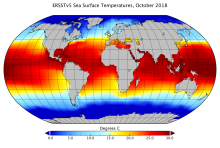 SST Data: NOAA Extended Reconstruction SSTs Version 5 (ERSSTv5)
SST Data: NOAA Extended Reconstruction SSTs Version 5 (ERSSTv5)
Years of record
- to
Note: ERSST is currently on version 6. See the ERSSTv6 page here. The NOAA Extended Reconstruction Sea Surface Temperature (ERSST) provides global, spatially complete SST data at a monthly timestep for 1854-present. Version5 is based upon statistical interpolation of the ICOADS release 3.0 data. Argo float data are used in the recent years (since ~2000). The data…
-
Timestep
- Climatology, Monthly
-
Domain
- Global
-
Collections
- Diagnostic Data Sets
Experts contributing reviews
- Hausfather, Zeke
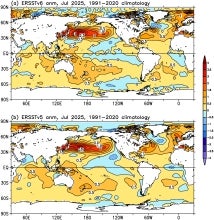 SST Data: NOAA Extended Reconstruction SSTs Version 6 (ERSSTv6)
SST Data: NOAA Extended Reconstruction SSTs Version 6 (ERSSTv6)
Years of record
- to
The NOAA Extended Reconstruction Sea Surface Temperature version 6 (ERSSTv6) is a global, spatially complete SST data at monthly 2°×2° resolutions based on in situ observations for 1850-present. Version 6 is based upon statistical interpolation of the ICOADS release 3.0.2 SST data. Argo float data are also used in the recent years (since ~2000). The data are distributed…
Experts contributing reviews
- Huang, Boyin, Yin, Xungang
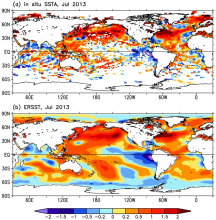 SST data: NOAA Extended Reconstruction SSTs, version 3 (ERSSTv3 & 3b)
SST data: NOAA Extended Reconstruction SSTs, version 3 (ERSSTv3 & 3b)
Years of record
- to
Note: ERSST is currently on version 6. See the ERSSTv6 page here. The NOAA Extended Reconstruction Sea Surface Temperature (ERSST) provides global, spatially complete SST data at a monthly timestep for 1854-present. Version3 is based upon statistical interpolation of the ICOADS release 2.4 data. Version 3 includes satellite AVHRR SST data for 1985 onwards. Version…
-
Timestep
- Monthly
-
Domain
- Global
Experts contributing reviews
- Huang, Boyin, Livermore, Jay, Smith, Tom
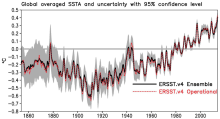 SST data: NOAA Extended Reconstruction SSTs, Version 4
SST data: NOAA Extended Reconstruction SSTs, Version 4
Years of record
- to
Note: ERSST is currently on version 6. See the ERSSTv6 page here. The NOAA Extended Reconstruction Sea Surface Temperature (ERSST) provides global, spatially complete SST data at a monthly timestep for 1854-present. Compared to the previous version, Version 4 uses the more extensive ICOADS Release 2.5 data and revised quality control, bias adjustment, and…
Experts contributing reviews
- Huang, Boyin
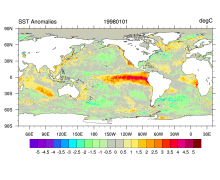 SST data: NOAA High-resolution (0.25x0.25) Blended Analysis of Daily SST and Ice, OISSTv2
SST data: NOAA High-resolution (0.25x0.25) Blended Analysis of Daily SST and Ice, OISSTv2
Years of record
- to
"NOAA’s Optimum Interpolation Sea Surface temperature (OISST, also known as Reynolds’ SST) is a series of global analysis products, including the weekly OISST on a 1° grid to the more recent daily on a ¼° grid. An SST analysis is a spatially gridded product created by interpolating and extrapolating data, resulting in a smoothed complete field. OISST provides global…
Main variables and Earth System components
Cryosphere Sea Ice Concentration Ocean SST - sea surface temperatureExperts contributing reviews
- Banzon, Viva, Reynolds, Richard
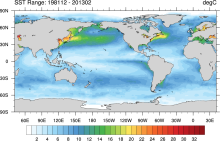 SST data: NOAA Optimal Interpolation (OI) SST Analysis, version 2 (OISSTv2) 1x1
SST data: NOAA Optimal Interpolation (OI) SST Analysis, version 2 (OISSTv2) 1x1
Years of record
- to
The NOAA Optimal Interpolation SST analysis provides global, spatially complete SSTs on a weekly and monthly basis for 1982-present.
Experts contributing reviews
- Banzon, Viva, Reynolds, Richard
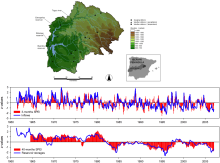 Standardized Precipitation Evapotranspiration Index (SPEI)
Standardized Precipitation Evapotranspiration Index (SPEI)
Years of record
- to
The Standardized Precipitation Evapotranspiration Index (SPEI) is an extension of the widely used Standardized Precipitation Index (SPI). The SPEI is designed to take into account both precipitation and potential evapotranspiration (PET) in determining drought. Thus, unlike the SPI, the SPEI captures the main impact of increased temperatures on water demand. Like the…
Main variables and Earth System components
N/AExperts contributing reviews
- Vicente-Serrano, Sergio M.
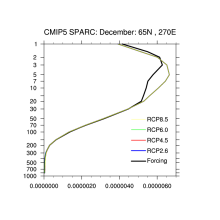 Stratospheric & Tropospheric Ozone: ACC/SPARC (Atmospheric Chemistry and Climate / Stratospheric Processes and their Role in Climate)
Stratospheric & Tropospheric Ozone: ACC/SPARC (Atmospheric Chemistry and Climate / Stratospheric Processes and their Role in Climate)
Years of record
- to
"The AC&C/SPARC ozone database covers the period 1850 to 2100 and can be used as forcing in climate models that do not include interactive chemistry. The historical part of the AC&C/SPARC ozone database spans the period 1850 to 2009 and consists of separate stratospheric and tropospheric data sources: (1) A multiple linear regression analysis of SAGE I+II…
-
Formats
- netCDF
-
Timestep
- Monthly
-
Domain
- Global
-
Collections
- Boundary Conditions, CMIP5-recommended, AC&C/SPARC ozone
Experts contributing reviews
- N/A
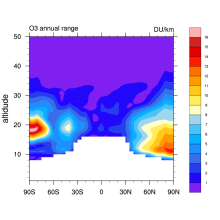 Stratospheric Ozone: Randel & Wu 2007
Stratospheric Ozone: Randel & Wu 2007
Years of record
- to
This is a monthly, zonal-mean ozone profile data set spanning 1979–2005 for altitudes from the tropopause up to 50 km. Interannual variability is based on a combination of SAGE (Stratospheric Aerosol and Gas Experiment) satellite profile measurements and polar ozonesondes. The interannual anomalies were added to a climatology from Fortuin and Kelder (1998). …
-
Formats
- binary
-
Timestep
- Monthly
-
Domain
- Global
-
Collections
- Boundary Conditions
Experts contributing reviews
- Randel, Bill
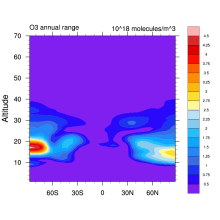 Stratospheric Ozone: Vertically Resolved, zonal mean based on BDBP
Stratospheric Ozone: Vertically Resolved, zonal mean based on BDBP
Years of record
- to
Combined monthly mean vertical ozone profile database spanning the period 1979 to 2007. The database is completely filled such that there are no missing data. The raw individual ozone data are sourced from the BDBP database. Monthly means are calculated from individual ozone measurements extracted from the BDBP in much the same way as in Hassler et al. (2009).…
Experts contributing reviews
- Hassler, Birgit
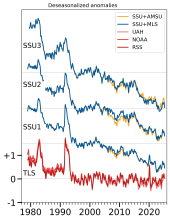 Stratospheric Temperature: Satellite Datasets Used to Quantify Lower, Middle, and Upper Stratospheric Temperatures
Stratospheric Temperature: Satellite Datasets Used to Quantify Lower, Middle, and Upper Stratospheric Temperatures
Years of record
- to
The temperature of the stratosphere is a key climate variable for understanding variability and change of the Earth's radiation budget, particularly due to sensitivity to changes in stratospheric ozone as well as aerosols from volcanoes and wildfires. While there are direct measurements of the lower stratosphere with weather balloons and field campaigns, complete…
-
Formats
- N/A
-
Timestep
- Monthly
-
Domain
- Global
-
Collections
- BAMS State of the Climate
Experts contributing reviews
- Randel, Bill, Starr, Jon
 Surface Flux and Meteorological Dataset: National Oceanography Centre (NOC) V2.0
Surface Flux and Meteorological Dataset: National Oceanography Centre (NOC) V2.0
Years of record
- to
The National Oceanography Centre (NOC) Version 2.0 Surface Flux and Meteorological Dataset is a monthly mean gridded dataset of marine surface measurements and derived fluxes constructed using optimal interpolation. Input for the period 1973 to 2006 are ICOADS Release 2.4 ship data and the update from 2007 to 2014 uses ICOADS Release 2.5. The dataset is presented…
-
Formats
- netCDF
-
Timestep
- Monthly
-
Domain
- Global
-
Collections
- Climate Data Record
Experts contributing reviews
- Kent, Elizabeth
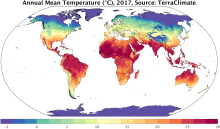 TerraClimate: Global, high-resolution gridded temperature, precipitation, and other water balance variables
TerraClimate: Global, high-resolution gridded temperature, precipitation, and other water balance variables
Years of record
- to
TerraClimate is a global gridded dataset of meteorological and water balance variables for 1958-present, available on a monthly timestep. Its relatively fine spatial resolution, global extent, and long length are a unique combination that fills a void in climate data. TerraClimate combines spatial climatology from WorldClim with time-varying information from the…
Main variables and Earth System components
Atmosphere Air Temperature Maximum Air Temperature Minimum Air Temperature Potential Evapotranspiration Precipitation Wind Snow Water Equivalent Land evapotranspiration Runoff and Streamflow Soil MoistureExperts contributing reviews
- Abatzoglou, John
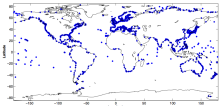 Tide gauge sea level data
Tide gauge sea level data
Years of record
- to
The global sea level record from tide gauges is an important indicator of the evolution and impact of global change. Tide gauge data also capture a variety of local and regional phenomena related to decadal climate variability, tides, storm surges, tsunamis, swells, and other coastal processes. Tide gauge data are used to validate ocean models and to detect…
-
Formats
- N/A
-
Timestep
- Sub-daily, Daily, Monthly, Annual
-
Domain
- Global
-
Collections
- N/A
Experts contributing reviews
- Hamlington, Benjamin, Thompson, Phil
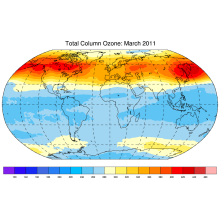 Total Column Ozone: Bodeker Scientific
Total Column Ozone: Bodeker Scientific
Years of record
- N/A
Bodeker Scientific produces global, daily, total column ozone database by combining measurements from a number of different satellite-based instruments. Offsets and drifts between the different datasets are resolved through comparisons with the Dobson and Brewer ground-based instruments and through inter-satellite instrument comparisons. Three versions with different…
Experts contributing reviews
- N/A
 Total Column Water Vapor: Integrated Water Vapor from GNSS stations
Total Column Water Vapor: Integrated Water Vapor from GNSS stations
Years of record
- to
Total Column Water Vapor (TCWV) or Integrated Water Vapor (IWV) is a key measure of the quantity of moisture held in the atmosphere at given locations. Water vapor is a key variable for understanding the moist energetics of the atmosphere and therefore the circulation as well as the radiative properties due to its strong absorption at most frequencies in the long-wave…
-
Formats
- ascii
-
Timestep
- Sub-daily, Daily, Monthly
-
Domain
- Global
-
Collections
- BAMS State of the Climate
Experts contributing reviews
- N/A
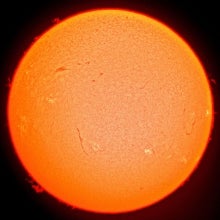 Total Solar Irradiance (TSI) datasets: An overview
Total Solar Irradiance (TSI) datasets: An overview
Years of record
- to
The solar radiation arriving at Earth (once known as the “solar constant”, now usually referred to as Total Solar Irradiance (TSI)), is the most fundamental of climate parameters as it indicates the totality of the energy driving the climate system. All climate models need to prescribe a value for it, either explicitly or implicitly, but its measurement with the…
-
Formats
- N/A
-
Timestep
- N/A
-
Domain
- Global
-
Collections
- N/A
Experts contributing reviews
- Ball, William, Haigh, Joanna
 Tree-ring width chronologies: An overview of their use as climate proxies and of available databases
Tree-ring width chronologies: An overview of their use as climate proxies and of available databases
Years of record
- N/A
The width of an annual tree ring is a very simple indicator of the character of that year’s weather, but collectively the global network of tree-ring width measurements represents an invaluable resource for high-resolution paleoclimatology.
Main variables and Earth System components
N/A-
Formats
- N/A
-
Timestep
- Annual
-
Domain
- Global
-
Collections
- N/A
Experts contributing reviews
- St. George, Scott
 WASWind: Wave and Anemometer-based Sea Surface Wind
WASWind: Wave and Anemometer-based Sea Surface Wind
Years of record
- to
"WASWind (Wave and Anemometer-based Sea Surface Wind) provides a bias-corrected marine surface wind dataset over the global oceans. Variables include scalar, zonal and meridional winds at 10-meter high, and zonal and meridional components of wind stress. WASWind has been constructed from wind observations in ICOADS (International Comprehensive Ocean-Atmosphere Data Set…
Experts contributing reviews
- Tokinaga, Hiroki
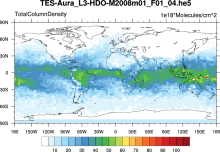 Water Isotopes from Satellites
Water Isotopes from Satellites
Years of record
- to
Summary of 7 satellite-derived products providing a global snapshot of water isotope distribution in 3D, with good information on zonal gradients and seasonality.
Experts contributing reviews
- Risi, Camille
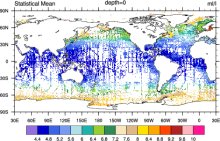 World Ocean Atlas (WOA09)
World Ocean Atlas (WOA09)
Years of record
- N/A
World Ocean Atlas 2009 (WOA09) is a set of objectively analyzed (1 degree grid) climatological fields of in situ temperature, salinity, dissolved oxygen, Apparent Oxygen Utilization (AOU), percent oxygen saturation, phosphate, silicate, and nitrate at standard depth levels for annual, seasonal, and monthly compositing periods for the World Ocean. It also includes…
Main variables and Earth System components
Ocean Dissolved Oxygen SST - sea surface temperature Salinity Sub Surface Salinity Sub Surface Temperature oxygen saturation phosphate silicate-
Timestep
- Climatology, Monthly, Seasonal, Annual
-
Domain
- Global
-
Collections
- Diagnostic Data Sets, NCAR-DOE-CESM, oceandiagnostics
Experts contributing reviews
- N/A
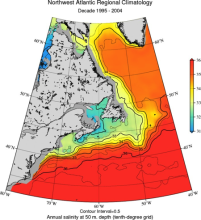 World Ocean Atlas 2013 (WOA13)
World Ocean Atlas 2013 (WOA13)
Years of record
- to
The World Ocean Atlas (WOA) is a set of climatological mean, gridded fields of oceanographic variables based on in-situ measurements from a wide variety of sources. Global, decadal averages of temperature, salinity, oxygen and nutrients are provided at monthly, seasonal and annual averaging periods on 102 standard depth levels from 0 to 5500m, and at 0.25° (…
Main variables and Earth System components
Ocean Dissolved Oxygen phosphate potential temperature silicate SST - sea surface temperature Sub Surface Salinity Sub Surface Temperature Sub-surface data-
Timestep
- Climatology, Monthly, Seasonal
-
Domain
- Global
-
Collections
- Diagnostic Data Sets, NCAR-DOE-CESM, oceandiagnostics
Experts contributing reviews
- Mishonov, Alexey